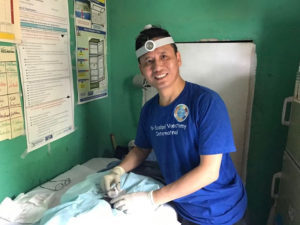The process of fat grafting is as follows:
First, the fat is removed via standard liposuction. For those who don’t know, liposuction is a simple procedure that removes fat from an area through a cannula (thin hollow tube) and aspirator (suction device). Laser liposuction is generally not used because they can destroy the fat cells. This isn’t a problem if you’re just getting liposuction, but if you’re putting the fat back into your body, you want the cells to be intact.
The fat is then processed to remove debris, fluids, and dead cells via decantation and centrifugation. In layman’s terms, the fluid in the bottom and the stuff floating on top gets poured out and then the fat remaining is further purified by filtering or spinning it around really fast.
Finally, fat is reinjected in small droplets under the skin. The reason it’s done in small droplets is to ensure proper blood supply to the fat graft so it can survive. Smaller droplets mean more surface area and hence, more blood supply.
Fat grafts are can be used in many different ways. We offer breast, buttock, face and hand augmentation with autologous fat transfer. Fat grafts can increase the volume and restore youthful appearance of the face, improve skin texture, increase breast size , correct breast asymmetry, contour the breast and buttocks, and reduce wrinkles in the hand. Fat grafts are a very useful cosmetic procedure.
 While the idea of fat grafting is not complicated, we have only recently been able to do so consistently and safely in practice. Fat grafting goes all the way back to the late 19th century, when German surgeon Gustav Neuber achieved the first recorded successful fat grafting procedure in transferring fat from the arm to the orbital region to fix scars from osteomyelitis, a bone infection. Two years later, Viktor Czerny transferred a lipoma (a fatty lump under the skin) to the breast to correct the size difference following a mastectomy. While these two showed that fat grafting was possible, fat grafting failed to gain acceptance for the next century due to the many possible complications that would arise as a result of the procedure. It wasn’t until the 90s, when Dr. Sydney Coleman developed standardized structural fat grafting techniques, that the procedure became popular.
While the idea of fat grafting is not complicated, we have only recently been able to do so consistently and safely in practice. Fat grafting goes all the way back to the late 19th century, when German surgeon Gustav Neuber achieved the first recorded successful fat grafting procedure in transferring fat from the arm to the orbital region to fix scars from osteomyelitis, a bone infection. Two years later, Viktor Czerny transferred a lipoma (a fatty lump under the skin) to the breast to correct the size difference following a mastectomy. While these two showed that fat grafting was possible, fat grafting failed to gain acceptance for the next century due to the many possible complications that would arise as a result of the procedure. It wasn’t until the 90s, when Dr. Sydney Coleman developed standardized structural fat grafting techniques, that the procedure became popular. MINNEAPOLIS, Minnesota — Dr. Steven Shu, founder of
MINNEAPOLIS, Minnesota — Dr. Steven Shu, founder of  Dr. Shu, MD, MBA, is a cosmetic surgeon and proceduralist and founder of MVI and Surgeon Volunteers. Since joining No-Scalpel Vasectomy International, Inc (NSVI), an international medical volunteer organization led by urologists Dr. Doug Stein and Dr. Ramon Suarez, in 2014, Dr. Shu has completed six mission trips to Haiti and the Philippines.
Dr. Shu, MD, MBA, is a cosmetic surgeon and proceduralist and founder of MVI and Surgeon Volunteers. Since joining No-Scalpel Vasectomy International, Inc (NSVI), an international medical volunteer organization led by urologists Dr. Doug Stein and Dr. Ramon Suarez, in 2014, Dr. Shu has completed six mission trips to Haiti and the Philippines. Saline implants were invented shorty afterward by a French medical device company in 1964 which were similar to the silicone implants, but contained saline rather than silicone in the bag. In 1992, when the FDA banned silicone injections, they also banned silicone gel implants due to the possible health risks and seeing horrible consequences of injections. During this 15 year moratorium on silicone gel implants, saline stepped up to the plate, becoming the most common implant material by a huge margin (95% of implants in the 90s were saline).
Saline implants were invented shorty afterward by a French medical device company in 1964 which were similar to the silicone implants, but contained saline rather than silicone in the bag. In 1992, when the FDA banned silicone injections, they also banned silicone gel implants due to the possible health risks and seeing horrible consequences of injections. During this 15 year moratorium on silicone gel implants, saline stepped up to the plate, becoming the most common implant material by a huge margin (95% of implants in the 90s were saline).





